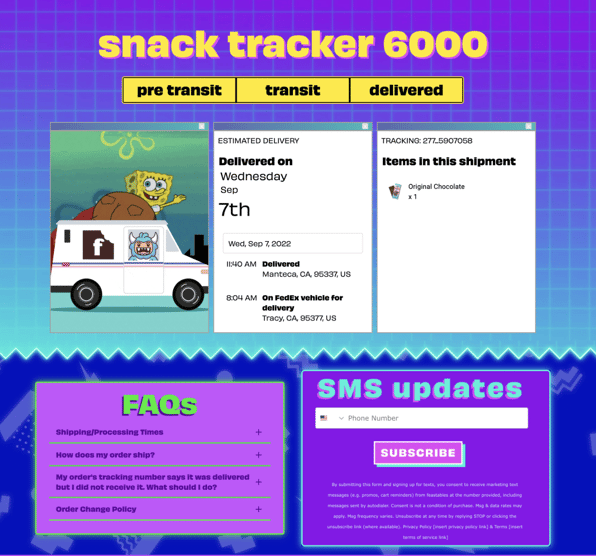Unveiling the Secrets: The Anatomy of an A+ Tracking Page Experience

Closing the loop on transactional messaging to drive revenue, reduce support tickets and engage customers
Transactional messaging can be powerful. Providing proactive updates on the status of a shipment can make the difference in a customer feeling happy with a brand when their package gets lost. It can also be the cherry on top of a positive experience when a customer gets a notification that their order is arriving early.
But, sending updates along a package’s journey is just one of two core components of building a successful transactional messaging program. The other is the tracking page experience – the destination where users click into. The tracking page is where shipment status information, frequently asked questions, upsells and marketing-focused content are placed to do many of the things that Wonderment is built for.
With Wonderment, a brand building a tracking page has the ability to leverage sections in their Shopify Online Store 2.0 theme in a no-code environment (if they choose). This allows for maximum flexibility with content formatting with updates to a tracking page that can be made directly inside of theme settings in Shopify. Here are a selection of key components for tracking pages that help to drive revenue, reduce customer support tickets and help customers engage with the brands they love.
Tracking Widget
Of course, the primary focus of an order tracking page should be to give customers as clear of information as possible about the status of their order. That starts with simply embedding the Wonderment tracking widget near the top of a page, either below a headline or below a main banner image. Teams that work with a developer may want to have them overlay a tracking widget on top of a banner image.
FAQs
Proactive, automated messaging along a shipment’s journey is better for customers and brands. Customers do not have to reach out to support for WISMO (Where is my order?) tickets and brands then do not have to be reactive to those inquiries. Another component to mitigating customer service tickets, though, is having clear, but also concise, frequently asked questions on a tracking page.
Many brands will have a general FAQs page that covers many topics. The tracking page FAQs should focus on shipping, returns and exchanges and product use questions. In the case of Promix Nutrition, the section that customers see on their tracking page contains a simplified set of three shipment-related questions and answers.
Product Recommendations
Any standard Shopify theme (free or paid) is going to have a section that allows the display of a collection of products in a grid or slider format. Use that section to display popular best sellers, new products or sale items.
Bonus: While these common categories can be impactful, take the recommended products concept a step further by personalizing a customer’s experience. Brands that use Rebuy can create a widget of featured products that dynamically displays products based on the page visitor’s purchase and browsing history.
Featured Content
This is where brands can get creative. Keep in mind that the users visiting the order tracking page are either first-time customers that a brand should want to turn into long-term, repeat-buying brand evangelists or they already are exactly that. So, dedicate another section of the page to displaying content like:
- A banner for a newly-released product
- Entry form for a product giveaway actively running
- An embedded social post that has historically performed well
Other
This tracking page serves as prime real estate to showcase anything you'd like to share with your customers- loyalty programs, refer a friend links, review requests, post-purchase surveys, starting a return, etc. You have full control over the content you'd like to add.
Conclusion
When a brand sends customers a tracking number and directs them to a Google search, there is a massive missed opportunity to create a positive experience and upsell a user into making an additional purchase. Brands can do both by creating a simple yet effective on-site tracking page.



